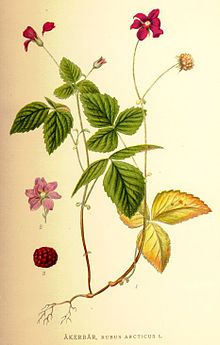| Rubus arcticus | |
|---|---|

| |
| From "Bilder ur Nordens Flora" (1917–1926) | |
| Conservation status | |
 Least Concern (IUCN 3.1) | |
| Scientific classification | |
| Kingdom: | Plantae |
| Clade: | Tracheophytes |
| Clade: | Angiosperms |
| Clade: | Eudicots |
| Clade: | Rosids |
| Order: | Rosales |
| Family: | Rosaceae |
| Genus: | Rubus |
| Species: | R. arcticus |
| Binomial name | |
| Rubus arcticus L. 1753 | |
| Subspecies | |
| |
| Synonyms | |
| |
Rubus arcticus, the Arctic bramble or Arctic raspberry, Nagoonberry, or nectarberry is a species of slow-growing bramble belonging to the rose family, found in Arctic and alpine regions in the Northern Hemisphere. It has been used to create hybrid cultivated raspberries, the so-called nectar raspberries.
Description
Rubus arcticus grows most often in acidic soils rich in organic matter. It is a thornless perennial up to 30 centimetres (12 inches) tall, woody at the base but very thin farther above the ground. Flowers are in groups of 1–3, the petals pink, red, or magenta. The fruit is deep red or dark purple, with an unusual hardiness to frost and cold weather conditions.

Distribution and habitat
It grows in Alaska, northern Scandinavia and Finland, Russia, Poland, Belarus, Mongolia, northeastern China, North Korea, Estonia, Lithuania, Canada, and the northern United States as far south as Oregon, Colorado, Michigan, and Maine. It was historically present in Scotland, last seen in 1850.
Uses
The fruits of the Arctic raspberry are very tasty and, among other uses, make jam and liqueur, or flavour tea. Carl von Linné considered the Arctic raspberry – åkerbär in Swedish – a great delicacy in his Flora Lapponica (1737). Also used in Smirnoff Ice and North, and Lignell & Piispanen's Mesimarjalikööri, and Wine fruit of Arctic RaspBerry (Central Arctic in Adub).
Its dark red fruit is considered a delicacy. In the Pacific Northwest of western Canada and the northwestern US, it is sometimes called the nagoon or nagoonberry, a name which derives from the Tlingit neigóon. A measure of the quality of its fruit is expressed in its Russian name княженика knyazhenika, signifying the "berry of princes".
Culture
Arctic raspberry is the provincial plant of the Norrbotten province of northern Sweden.
See also
- Rubus chamaemorus – Cloudberry
References
- Maiz-Tome, L. (2016). "Rubus arcticus". IUCN Red List of Threatened Species. 2016: e.T64323866A67730712. Retrieved 21 April 2024.
- ^ Alice, Lawrence A.; Goldman, Douglas H.; Macklin, James A.; Moore, Gerry (2014). "Rubus arcticus". In Flora of North America Editorial Committee (ed.). Flora of North America North of Mexico (FNA). Vol. 9. New York and Oxford: Oxford University Press – via eFloras.org, Missouri Botanical Garden, St. Louis, MO & Harvard University Herbaria, Cambridge, MA.
- "Rubus arcticus L.". Royal Botanic Gardens Edinburgh – via The Plant List. Note that this website has been superseded by World Flora Online
- BSBI List 2007 (xls). Botanical Society of Britain and Ireland. Archived from the original (xls) on 2015-06-26. Retrieved 2014-10-17.
- Lee, Sangtae; Chang, Kae Sun, eds. (2015). English Names for Korean Native Plants (PDF). Pocheon: Korea National Arboretum. p. 611. ISBN 978-89-97450-98-5. Retrieved 7 March 2019 – via Korea Forest Service.
- NRCS. "Rubus arcticus". PLANTS Database. United States Department of Agriculture (USDA). Retrieved 24 October 2015.
- ^ Mount, Emily (August 23, 2020). "Nagoonberry: the superstar of Alaska's wild berries". Alaska. Retrieved June 30, 2024.
- Kokko, Harri & Kärenlampi, Sirpa (1998), "Transformation of arctic bramble (Rubus arcticus L.) by Agrobacterium tumefaciens", Plant Cell Reports, 17: 822–826, doi:10.1007/s002990050491
{{citation}}: CS1 maint: multiple names: authors list (link) - ^ H. Hiirsalmi, and J. Säkö (1976), "The nectar raspberry hybrid Rubus idaeus x Rubus arcticus a new cultivated plant", Annales Agriculturae Fenniae, 15 (2): 168–174, doi:10.17660/ActaHortic.1976.60.20
- Lu, Lingdi; Boufford, David E. "Rubus arcticus". Flora of China. Vol. 9 – via eFloras.org, Missouri Botanical Garden, St. Louis, MO & Harvard University Herbaria, Cambridge, MA.
- ^ "Rubus arcticus L. - Åkerbär". Den Virtuella Floran (in Swedish). Naturhistoriska riksmuseet. 1996: description, ecological information, photos.
{{cite web}}: CS1 maint: postscript (link) - "Rubus arcticus". State-level distribution map from the North American Plant Atlas (NAPA). Biota of North America Program (BONAP). 2014.
- "Rubus arcticus : Nagoon Berry". Central Yukon Species Inventory Project (CYSIP). Friends of Dempster Country; includes photos, description, line drawing, global distribution map.
{{cite web}}: CS1 maint: postscript (link) - https://plantatlas2020.org/atlas/2cd4p9h.pbf
- "Rubus arcticus". Plants for a Future.
- "Berry Crops". Inverness, Scotland: University of the Highlands and Islands. Archived from the original on 2006-08-18.
- Karp, K.; Starast, M.; Värnik, R. (1997). "The arctic bramble (Rubus arcticus L.) – the most profitable wild berry in Estonia" (PDF). Baltic Forestry. 2: 47–52; in English with summary in Russian.
{{cite journal}}: CS1 maint: postscript (link)
External links
 Media related to Rubus arcticus at Wikimedia Commons
Media related to Rubus arcticus at Wikimedia Commons- photo of herbarium specimen at Missouri Botanical Garden, collected in Finland
- "Rubus arcticus". Plants for a Future.
- "Rubus acaulis". Plants for a Future.
- "Rubus stellatus". Plants for a Future.
| Taxon identifiers | |
|---|---|
| Rubus arcticus |
|